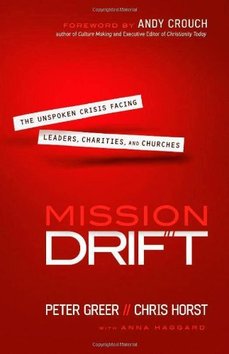Disciples making disciples
 “One more click to the right,” he said, and then almost asked, “and maybe one more up...?” The adjustment was so small it was undetectable. At close range, it wouldn’t have hardly mattered, but at 400 yards it was the difference between a bullseye and nearly missing the entire target. The dull ping of the metal target that followed the next shot confirmed the changes to be exactly what was needed. As we approached the target for a closer look, there was a satisfaction in seeing the dent so near the center. Nice! That day we spent on the range came back to me as I was reviewing the book, Mission Drift, that Doug recommended to our Elders several months back. The purpose of the work is to challenge God’s people, entrusted with carrying His Church through this period of history, to consider where we’ve gone and where we’re going with it from here. Mission Drift features several case studies of Christian organizations that were founded with a strong understanding of their mission and their specific purposes within the Kingdom of God. Often innovative and fresh, the work and success of these organizations became well-known, many growing to international scale, and were celebrated for the great impact they had for the cause of Jesus and His Kingdom. As the organization matured, each mission faced the need for adjustment and change, whether because of the scale of growth, a change of key personnel, or in answer to mounting pressures internally and from the outside. Here the authors press the case that it is at these crucial junctures that the mission is either reinforced and strengthened or compromised. In the event of concession, the deviance is usually hailed as a good thing or, at least, a regrettable necessity. Either way, the change is subtle and seems of no consequence. Like the few clicks on the foresight of the rifle, in the immediate period -- the close range -- after the changes, things seem to be in good shape. But over time the Drift becomes progressively obvious. A generation passes. The New becomes the conventional. Interestingly, as the evidence of drift becomes more clear, it is seldom a question of whether the organization needs to be “righted.” Remember, the new has become the norm, and nearly all of the active members and leaders have come aboard since the changes were instituted and so regard the current mission as The Mission. And they like it this way. Enough to ignore concerns. The original ideas are dismissed. And the pattern continues, generation after generation. Mission Drift also chronicles several Christian organizations who, at one of these junctures, considered making core mission changes and decided to stay the original course. They were often regarded as short-sighted, culturally out of touch, or even narrow by outsiders at the time, but over time they have remained true and continue to serve. Reading this book led to pondering. And pondering led to questioning. It had me asking if any part of the Kingdom’s mission or message had been deleted or altered in the Western church over the centuries. In church history, we recognize the numerous “resets” led by the Holy Spirit, as well as the ill-fated, human-driven attempts at reform that resulted from what seems the almost inevitable tendency toward the Drift. But, in the end, the soul-searching had to come all the way to us at FCC. In the end, it came to this. The Mission Drift began in my own life. What was I investing in? Where was my true center? Where were we heading? Were we getting there? Was my mission the same as Jesus’ mission? I think I came up a bit short, but it was like a breath of fresh air to bring it into focus. There’s a lot of really good things into which I can invest my life, but not all of them cut the mustard when laid against the backdrop of the Kingdom! This might just be liberating! You see, doing church work automatically has you assuming you’re doing Kingdom work... but somewhere down inside, you sometimes wonder. Am I really making disciples who make disciples ready to make disciples? Do I even know what a disciple looks like? Assessing my many years of ministry left me thinking my results resembled more an undirected shotgun blast than a carefully planned pinpoint shot. Thus the “reset”. In two startlingly simple teachings we call the Great Command (Matthew 22:34-40) and the Great Commission (Matthew 28:18-20), he clarified our Mission: Love God. Love People. Make Disciples. It was exactly what He did when He walked the earth. Loving the Father, loving all the people regardless of their response, and making disciples that turned the world upside-down and set an unstoppable force -- called His Church -- in motion until He returns to restore everything to His liking. The question for us is whether we are willing to join Him in that endeavor, reset from the Drift and make it happen? Leave a Reply. |
Dean Crist
Working through the process of being the man Jesus intentioned for me... while we work through the process of becoming the church Jesus intentioned for us to be Archives
December 2020
Categories |
Proudly powered by Weebly

 RSS Feed
RSS Feed